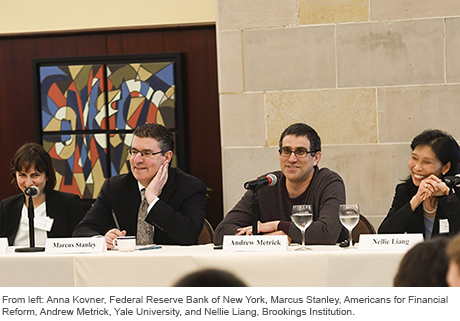Were Banks Ever ‘Boring’?

In a previous post, I documented that much of the expansion into nontraditional activities by U.S. banks began well before the passage of the Gramm-Leach-Bliley Act in 1999, the legislation that repealed much of the Glass-Steagall Act of 1933. The historical record actually contains many prior instances of the Glass-Steagall restrictions being circumvented, with nonbank firms allowed to operate as financial conglomerates and engage in activities that go beyond traditional banking. These broad industry dynamics might indicate that the business of banking tends to expand firm boundaries beyond a traditional—“boring”—perimeter.
Were Banks ‘Boring’ before the Repeal of Glass‑Steagall?
At the New York Fed: Twelfth Annual Joint Conference with NYU‑Stern on Financial Intermediation

Anyone who has a savings account, has taken out a mortgage, or has been part of a business seeking new capital has relied on the smooth functioning of the institutions and markets that collectively perform financial intermediation. Because financial intermediation is so critical to the functioning of a modern economy, it is important to understand its inner workings—its fundamental features, recent innovations, and lines of transmission to real economy activity, as well as its imperfections and its interactions with regulatory policies. As part of an ongoing effort to foster such an understanding, the Federal Reserve Bank of New York recently hosted the twelfth annual Federal Reserve Bank of New York–New York University, Stern School of Business Conference on Financial Intermediation. In this post, we explore some of the discussions and findings from the May 10 conference, which focused on recent advances in the study of financial intermediation.
Low Interest Rates and Bank Profits
Are Banks Being Roiled by Oil?

Profits and employment in the oil and natural gas extraction industry have fallen significantly since 2014, reflecting a sustained decline in energy prices. In this post, we look at how these tremors are affecting banks that operate in energy industry–intensive regions of the United States. We find that banks in the “oil patch” have experienced a significant rise in delinquencies on commercial and industrial loans. So far though, there appears to be limited evidence of spillovers to other types of loans and no evidence of widespread bank losses or failures in these regions.
Banking Deserts, Branch Closings, and Soft Information
U.S. banks have shuttered nearly 5,000 branches since the financial crisis, raising concerns that more low-income and minority neighborhoods may be devolving into “banking deserts” with inadequate, or no, mainstream financial services.
Becoming a Large Bank? It’s Not Easy
Rajlakshmi De and Hamid Mehran Size is usually seen as the leading indication of the costs that a bank failure would impose on society. As a result, the Dodd-Frank Act of 2010 requires banks to have adequate capital and liquidity to mitigate default risk and imposes additional requirements on larger banks to enhance their safety. […]
Are BHC and Federal Reserve Stress Test Results Converging? What Do We Learn from 2015?
In March, the Federal Reserve and thirty-one large U.S. bank holding companies (BHCs) announced results of the latest Dodd-Frank Act-mandated stress tests. Some commentators have argued that BHCs, in designing their stress test models, have strong incentives to mimic the Fed’s stress test results, since the Fed’s results are an integral part of the Federal Reserve’s supervisory assessment of capital adequacy for these firms. In this post, we look at the 2015 stress test projections by the eighteen largest U.S. BHCs and by the Fed and compare them to similar numbers from 2013 and 2014. As stress testing becomes more established, do we see evidence that the BHCs are mimicking the Fed?
Measuring Global Bank Complexity
Paraphrasing a famous Supreme Court opinion: “I know bank complexity when I see it.”
The Fragility of an MMF‑Intermediated Financial System
Since the financial crisis of 2007-09—and, in particular, the run on prime money market funds (MMFs) in September 2008—policymakers have been concerned that the funds’ fragility may render banks themselves more susceptible to risk.












 RSS Feed
RSS Feed Follow Liberty Street Economics
Follow Liberty Street Economics